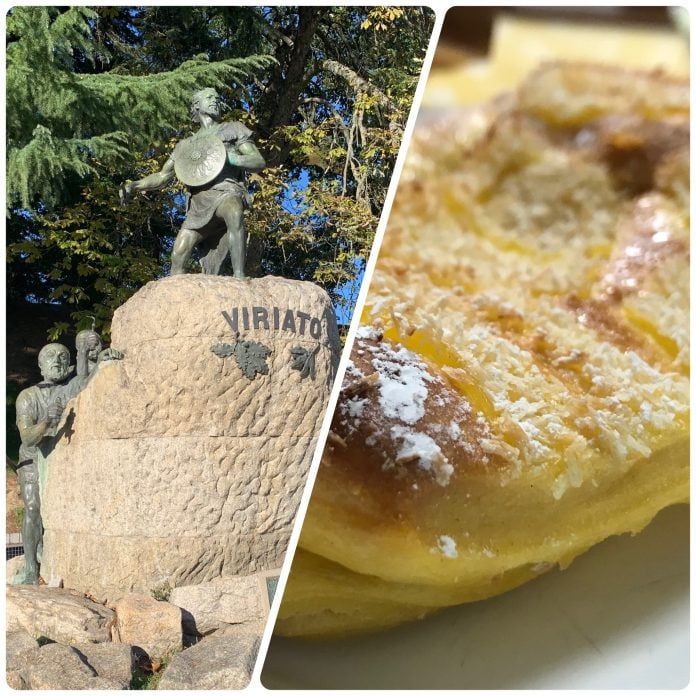In Viseu, one of the oldest Portuguese cities, right next to one of its thousand and one roundabouts, visitors can admire the statue of one of the most famous warriors of Portuguese mythology.
It is the figure of Viriato, represented with a sword in his hands and a piercing gaze, promptly fighting the Roman invader.
According to Jose Hermano Saraiva, in his book “História Concisa de Portugal” (Concise History of Portugal), Viriato lived between 147-139 BC. Of unknown birthplace, what is important to highlight is his bravery and courage, as he represented a superior resistance to the Roman invader.
We have to go back a long way to situate ourselves and understand the challenges of that time. We would have to wait a few hundred years to enter the Middle Ages and another hundred years to even hear the name Portugal mentioned.
We speak of a time of the conquest of the Roman legions against the peoples they called barbarians over a European territory far removed from our reality.
And it was during these various conquests that when the Romans reached the Iberian Peninsula, although they did not meet Asterix or Obelix, they found themselves up against warriors who were fierce defenders of their lands.
Within these peoples, the Lusitanian tribes did not give in to the continuous attempts of the enemy coming from Rome. And at the head of his tribes, Viriato stood out as the greatest warrior of this part of the Iberian Peninsula.
Several historians locate his birthplace in several different areas of what is now Portugal. Perhaps he was born in Évora, the capital of Lusitânia, or somewhere on the banks of the Guadiana River in the Algarve region.
But wherever his birth was, it is known from oral history passed down from generation to generation that Viriato would later settle in the area of the so-called Montes Hermínios, today known as Serra da Estrela.
Firstly as a shepherd, an activity that persists in these regions until today, Viriato would have no choice but to fight and become a warrior legend. As fate would have it, he passed through here, lived, fought, and died.
And it seems that the people from Viseu have the gift of always wanting to claim historical figures. Either to fill them with a magical mystique or to attract people to their land.
But whatever the real reasons, it is a fact that when visitors arrive in Viseu, Viriato’s statue recalls his story of centuries and centuries ago.
One navigates through time, seeing how his bravery was, nevertheless, a double-edged sword. While the statue recalls his strength, it also tells us of the three men behind him ready to stab him in the back.
Paid for by the Roman enemy, his companions shamefully betrayed him. And this was the only way the Romans found to conquer these invincible people.
However, more than the legacy of the statue, the name is alive in the city in every pastry shop a visitor enters. And if there were a thousand and one ways to pay tribute to such an emblematic figure, here in Beira Alta, confectioners decided to do it through our taste buds.
When entering one of these spaces, if you’re craving a different snack, then ask for a Viriato. You will be served a long cake, in the shape of a V — remembering the name of the legend who christened it— covered with coconut that can be eaten plain or with cheese and ham, according to each one’s taste.
The cake that has been delighting locals for several years was officially registered by “Confeitaria Amaral” in 1995, one of the most famous pastry shops in the city.
This famous pastry shop can be visited on Alexandre Lobo Street, near Rossio, the heart of the city. If you want to wander down Rua Direita, you will also find a second shop with the same name.
Even the most distracted will find it. Just follow the sweet aroma that perfumes the air, and you will soon come across Viriato, the cake, of course.
Fun fact, like the warrior, this pastry shop is also famous in the city for other conquests. Namely, for holding the Guinness record for the world’s most giant sausage roll!
So, if you’re not so much of a sweet tooth, you can enjoy the different savory pastries that fill the place.
You can either sit down, order a “galão” (a latte), a draft beer, or a freshly squeezed orange juice, or continue your walk around the city while delighting yourself with these new flavors.
Unfortunately, like other conventual sweets, the recipe seems to be under lock and key. But you can always try to copy it at home. As long as you know how to properly mix butter, flour, milk, and enough sugar, you may end up with your own cake baked at home!
Still, if you ask for one Viriato — I would recommend two at least— in a pastry shop, the result may be quite different. This is because, in addition to all these ingredients, the current Viriato pastries have cream and powdered sugar on top.
Those who have never tried this delicacy will always find it delicious and recommend it at any time of the day.
But locals know that the cake has also undergone changes throughout its existence. In the past, the cake was more like sweet bread with coconut and no cream that the children and young people of Viseu ate as a daily snack. One could say it was healthier back in the day!
Over time, cream and sugar were added, reconfiguring some of the original recipes.
One may look at this and the history of the warrior and ask: are the new pastry shops betraying the original Viriato? Or is it simply the ordinary course of baking history?
Oh well!
Whether or not, the cake continues to be delicious! And as we say around here, “what’s sweet, it’s always good.”


